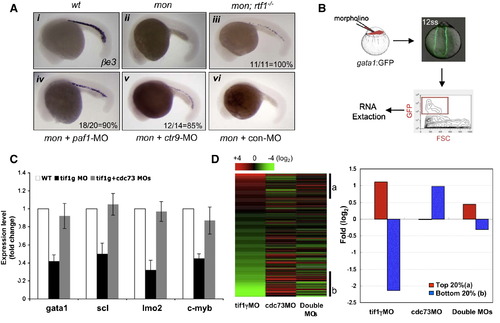Fig. 3
|
TIF1γ and PAF Antagonistically Regulate Erythroid Gene Expression (A) In situ hybridization of βe3 showing rescue of mon by depleting other PAF subunits. A 5 bp mismatch control morpholino for ctr9 was used in (vi). Rescue frequency (%) was shown in (iii–v). (B) Scheme of using gata1:GFP transgenic line to get RNA from erythroid cells in 12 ss zebrafish embryos. (C) Real-time RT-PCR analyses to compare the expression of blood genes in GFP+ cells between wild type and morphants. Results are shown as fold change relative to the wild-type control and normalized to expression of β-actin. The results presented as mean ± standard deviation (SD) from three independent experiments. (D) Microarray analysis to compare erythroid gene expression in gata1-GFP+ cells from morphants. Left: heat map of 243 erythroid signature genes. Right: a close-up look of average fold change of top 20% (a) and bottom 20% genes (b) from the heat map on the left. All microarray data have been deposited in the NCBI′s GEO database under the accession number GSE20432. See also Figure S2. |
| Genes: | |
|---|---|
| Fish: | |
| Knockdown Reagents: | |
| Anatomical Terms: | |
| Stage Range: | 10-13 somites to 26+ somites |
| Fish: | |
|---|---|
| Knockdown Reagents: | |
| Observed In: | |
| Stage Range: | 10-13 somites to 26+ somites |
Reprinted from Cell, 142(1), Bai, X., Kim, J., Yang, Z., Jurynec, M.J., Akie, T.E., Lee, J., LeBlanc, J., Sessa, A., Jiang, H., DiBiase, A., Zhou, Y., Grunwald, D.J., Lin, S., Cantor, A.B., Orkin, S.H., and Zon, L.I., TIF1gamma controls erythroid cell fate by regulating transcription elongation, 133-143, Copyright (2010) with permission from Elsevier. Full text @ Cell

